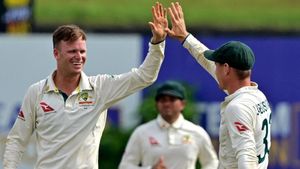Delhi Assembly Election Results 2025
February 8, 2025, marked a pivotal day for the Delhi Assembly elections as the counting of votes began from 8 AM, showcasing what has been billed as a highly electrifying contest among the leading candidates. The New Delhi constituency, particularly, has been under the spotlight due to the battle for the Chief Ministership, sparking heightened political rivalry.
The contest has seen incumbent Chief Minister Arvind Kejriwal representing the Aam Aadmi Party (AAP), Parvesh Verma from the Bharatiya Janata Party (BJP), and Sandeep Dikshit from the Indian National Congress (INC), all of whom carry significant political legacies.
Results have been closely watched following initial trends confirming BJP's lead. Parvesh Verma was reported to be leading early on, with Kejriwal trailing behind. By 8:38 AM, the momentum continued to favor Verma as he was seen gaining traction, eliciting fervent support outside Kejriwal's residence.
At the same time, Sandeep Dikshit expressed optimism about potential coalition discussions post-results, stressing the importance of letting the counting process transpire before drawing conclusions on alliances.
The dynamics were stark — with the BJP seeking to break its 27-year absence from power, Kejriwal aimed for his third consecutive term, and Congress, which has struggled in recent years, sought to reclaim relevance. The early trends indicated the BJP was securing leads on 38 seats, against AAP's 25, and the Congress holding just one, with potential shifts expected as counting progressed.
By mid-morning, BJP had shown strength across various constituencies. Reports indicated leads for party candidates such as Kapil Mishra from Karawal Nagar and Satish Jain from Chandni Chowk, alongside others. Meanwhile, AAP was finding success through candidates such as Praveen Kumar from Janakpuri.
Despite apprehensions, the voter turnout had been commendably high at 60.54% — the women voters, this time, comprised 60.92% of the electorate, marking a significant increase from past elections. This shift indicates potential changes within the electoral dynamics and the growing engagement of women voters.
The election has unfolded against the backdrop of various party promises and claims, with each party gearing its strategies to address the prevalent issues within the city, hoping to appeal to the electorate who expected actionable commitments this election.
Security was considerably heightened around counting centers. A three-tiered security system was employed to guard against any mishaps during what many anticipated could be contentious results announcement. The Election Commission deployed over 5,000 personnel across 19 counting centers to oversee the counting process.
This election’s gravity was highlighted when Kejriwal characterized the vote as not merely procedural but as reflective of larger ideological confrontations between good and evil, framing AAP's core proposition as virtuous.
Less than three hours after counting began, it was increasingly clear such age-old allegiances might be tested. BJP pursued to redefine itself amid national political narratives and aimed to combat the AAP, which claimed progress through its governance record over the past decade.
Adding to the intriguing political narrative, reports on constituency movements indicated some early predictions by exit polls were materializing, as BJP posters adorned many polling locations, echoing ambitions of change within Delhi. Early assertions communicated through the media and party spokespeople suggested BJP was gaining ground across multiple constituencies.
Congress leaders had arrived at counting centers with cautious optimism, acknowledging their role within the potential coalition talks should they find themselves strategically advantageous.
The telling results are closer than anticipated for both leading parties; as constituencies finalized their counts through the day, major networks and electoral platforms reported frequently updated figures and analyses. Election outcomes once finalized are promised to redefine the leadership dynamics across sectors within Delhi.
Rumor mill churned as voter sentiment was observed from various quarters offering insights differing significantly from presumptions, leading many to question uncertain future alignments.
Continuous rounds of updates indicated continued back-and-forth leading to rising tension among candidates and parties, with mere margins delineated between those winning and losing pivotal constituencies.
All eyes now linger on the outcome of New Delhi's results as Kejriwal confronts the descendancy of power amid legacies from both the BJP and Congress—Verma and Dikshit, respectively. Polling records set, humorous attempts to draw predictions replay and the larger political stakes at hand lay bare as the day continues to unravel.



